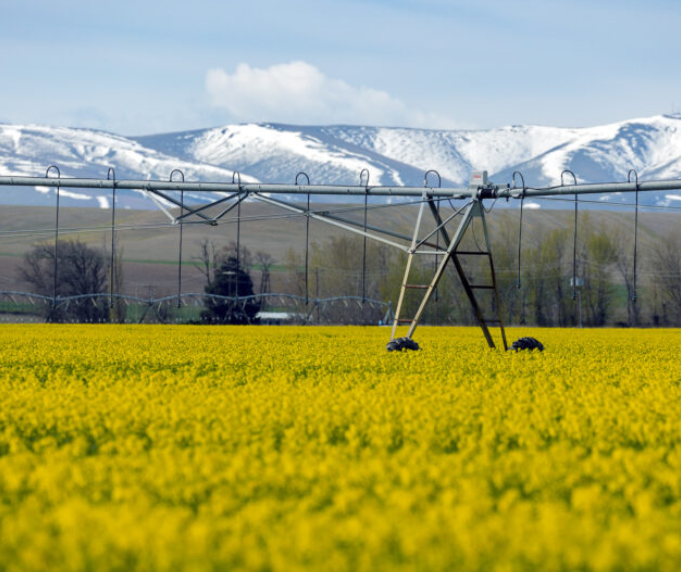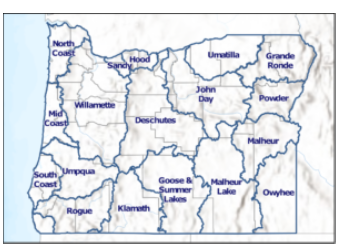Lawmakers want no new water rights permits issued until the state audits Oregon’s water resources

Oregon’s water basins are being overdrawn year after year, and a strategy to protect them for future generations is desperately overdue, according to two lawmakers.
State Reps. Ken Helm, D-Beaverton, and Mark Owens, R-Crane, say the Oregon Water Resources Department needs to stop issuing new water rights until it can provide data about the flow of water into and out of the state’s 20 basins each year, many of which are being sucked dry faster than the water can naturally be replaced. This is an issue across the West, where drought, river diversions and groundwater depletion have left parts of seven states scrambling to ration what water is available to them from the Colorado River Basin.
In Oregon, a majority of water permits are for agriculture, a $5 billion a year industry in the state.
Oregon’s 20 administrative water basins. (Oregon Water Resources Department)
Helm and Owens, chair and vice chair of the House Agriculture, Land Use, Natural Resources, and Water Committee, have proposed legislation that would order the Water Resources Department to stop approving new applications until the agency has calculated how much water exists in each basin and updates its permitting rules so water is not overdrawn. Permit holders include municipalities, businesses, farmers and agricultural districts relying on irrigation.
The legislation coincides with a push by Gov. Tina Kotek, lawmakers and industry to attract more semiconductor companies to the state and a push by data centers to expand. Both are heavy water users, consuming millions of gallons of water each day.
A statewide water analysis has not taken place since the 1980s, and the agency tracks the annual use of just 17% of water rights holders.
“We have to allow our communities to understand where they’re at,” Owens said. “Is there water left in the checkbook? Is there enough water for 100 years of planning and cities? Is there enough water to make sure we meet ecological targets with fish?”
A recent report from the Oregon Secretary of State’s Office called on the Water Resources Department and other state agencies to collaborate on a unified water conservation plan.
Under the proposed legislation, the Water Resources Department would have until December 2028 to report on how much surface and groundwater exists in each basin, including rivers, streams and underground aquifers, and how much is being drawn for uses such as agriculture, manufacturing and drinking water. The department then would need to update its rules so water cannot be overdrawn. It would also require water assessments to be updated every 10 years.
The bill is on the desk of House Speaker Dan Rayfield, D-Corvallis, and is likely to be discussed by the House agricultural and natural resources committee in mid-March, according to Owens’ water policy adviser, Harmony Burright. Proposals need to be scheduled for a vote by March 17 to continue in the legislative process.

One big user
About 85% of all the water diverted from rivers, streams and aquifers in Oregon is used for agriculture, according to a 2022 report by the Water Resources Department.
There are about 90,000 water rights holders in Oregon, and they wouldn’t be affected by the legislation. Nor would about 1,000 with applications in process.
If the bill passes, anyone applying for new water rights or transfers would have their application paused until the Water Resources Department wrapped up its work and rule changes.
“Our water accounts are overdrawn during the times of highest demand and there is not a plan in place to sustainably manage and maximize available water supplies,” the lawmakers wrote in a recent series of statements.
“The current system leaves communities, the economy and the environment vulnerable to water insecurity and costly conflict,” the statements said
No checks and balances
During the last 20 years, Oregon has experienced some of the driest conditions on record. Over 80% of water rights recently approved by the Water Resources Department are in areas where groundwater levels are declining, according to Danielle Gonzalez, policy section manager at the department.
In 2017, scientists at the department did not know whether groundwater was available to support the needs of 121 of 153 new water rights it issued, Gonzalez said in an email.
We wouldn’t ask a financial institution to continue writing checks without first assessing the status of their accounts to ensure those checks won’t bounce
– State Reps. Ken Helm, D-Beaverton, and Mark Owens, R-Crane.
Instead, the agency asked the permit holders to collect data and stop using water if supplies ran low, she said.
That’s bad policy, the lawmakers said.
“We wouldn’t ask a financial institution to continue writing checks without first assessing the status of their accounts to ensure those checks won’t bounce,” they said.
Only about 15,000 of the 90,000 water rights holders have to report their water use to the Water Resources Department because they are a public entity, in an area managed by public authorities or because their permit requires it, the department’s 2022 report said.
Learning firsthand
Owens said the problem of overdrawn basins became clear for him in 2015 when representatives from the Oregon Water Resources Department brought out a graph of data from the 1960s and ’70s that showed that every year natural processes like rain and snow melt refilled about 196,000 acre feet of water in the Harney Basin, yet the Water Resources Department had given away rights to 216,000 acre feet of water per year from the basin – or about 10% more than was being replenished.
“That didn’t make sense,” Owens said. “‘Surely this was a mistake?’” he recalled asking water officials.
The Harney Basin was being overdrawn, and it wasn’t a mistake or the first time it had happened, the officials said.
The water resources department is currently considering whether to designate the Harney Basin as a critical groundwater area, which would allow the agency to deny new permits or cut groundwater use, including setting limits on how much can be pumped.
The designation is a last resort and could have been prevented with better management, the lawmakers said.
“As the state’s water accountant, the Water Resources Department should be able to tell us the current status of basin water budgets and should only issue permits where they have a high degree of confidence that water will be available,” they said.
BY: ALEX BAUMHARDT
Oregon Capital Chronicle – 3/3/2023


Advertisement